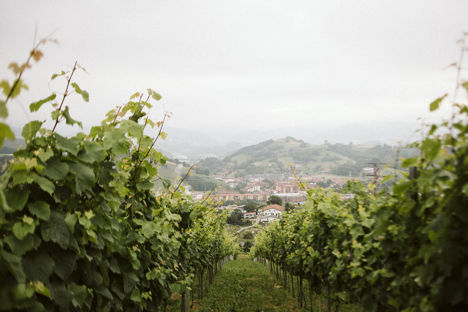
The wine regions of Spain: Txacolí
While the food of the Basque Country is justly famous throughout the world, its wine is still a bit of a secret. We delve into the history of Basque's winemaking renaissance, and take a look at some of its best vineyards.
The wine regions of Spain: Txacolí
While the food of the Basque Country is justly famous throughout the world, its wine is still a bit of a secret. We delve into the history of Basque's winemaking renaissance, and take a look at some of its best vineyards.
While the food of the Basque Country is justly famous throughout the world, its wine is still a bit of a secret. Historically, viticulture had been widespread throughout the region but was confined to small scale productions for personal use. In the mid-19th century txakolinas - village taverns - served locally produced wine with some accompanying food. However, the vine-destroying aphid phylloxera arrived around this time too, and destroyed most of the region’s vineyards. Due to this and other factors, such as industrialisation, vineyards in the Basque Country were practically abandoned.
It wasn’t until the 1980s that some local winemakers decided to breathe some life into the industry. Together they recovered the indigenous Hondarrabi Zuri and Hondarrabi Beltza grapes and employed modern techniques to make quality wine worthy of accompanying their great culinary output. In 1990 Txakolí de Guetaria (also known as Getaria Txakolina), the first of the Txakolí D.O.s, was created and while it is the smallest of the three in terms of land mass, it is the largest in terms of production.
The vast majority of the production of all three of the D.O.s is white wine mostly made from the Hondarrabi Zuri grape. All the wines are known as Txakolí after the 19th century name for the places where people went to drink wine, rather than after the grape variety or even the Basque name for wine, ardo. Because of the influence of the Atlantic on the climate, the grapes here are often grown in the hanging parral system. The grapes are highly acidic, making for a light, dry wine that is often slightly sparkling and best drunk young with fish and seafood. Although Txakoli’s renaissance started off with the semi-sparkling white, bodegas are now producing more still white, sparkling wine, rosé as well as a small amount of red thus strengthening Txakolí’s brand.
One of the newest vineyards in D.O. Txakolí de Guetaria is Hika. Located in the Oria Valley about 15 miles from San Sebastián, the business setup is a tribute to the txakolinas of old. The seven hectares of vertical vineyards enjoy a magnificent view of the valley and Mount Ernio, and are watched over by an imposing building. Designed and built by the San Sebastián-based Studio Hirigintza, it pays homage to the traditional country houses, caseríos, that were centres of cottage wine industries, many of them originally txakolinas.
On arrival it quickly becomes obvious that the whole vineyard is a modern high-tech version of a caserío. The wine making is located on the ground floor with the rest of the building being given over to the business of what accompanies the wine under the care of renowned local chef Roberto Ruiz. Rather than relegating wine to a disembodied product that has nothing to do with the rest of life, Hika have made it an integral part of their ecosystem. Using ultra local produce on display throughout the building, Ruiz and his team create food that matches the style of wine, be it the white, rosé or sparkling txakoli replicating the hospitality of old, and accompanied by the latest in technology in wine production and cooking. ‘We think of all of Hika as part of one thing,’ explained Ruiz, ‘you see the vineyard, you drink the wine, you try the local food all in the one space in the way that it used to be. We want you to experience a part of our culture when you visit.”
The menu highlights beans from Tolosa made with local black pudding and peppers, tomatoes from the nearby village of Arama with prime white tuna, squid cooked in ink in homage to José Juan Castillo, one of the great Basque chefs. All are perfectly matched with the Hika wine and sitting looking out at the vines while drinking the wine made from their grapes and eating locally produced food cooked to an incredibly high standard it is hard not to think that the people in this area have one of the best cultures for living around.
There are two other Txakolí D.O.s:
Txakolí de Vizcaya (also known as Bizkaiko Txakolina): created in 1994 this D.O. is in the province of Vizcaya and consists of vineyards in and around the city of Bilbao. Over 90% of the production is white wine and the vast majority of that is the indigenous Hondarrabi Zuri. The small rosé production is called ojo de gallo (rooster’s eye) while the small amount of red wine is mostly made from Hondarrabi Beltza. Quite a small amount of Txakolí de Vizcaya is made in total, and as it is very popular in Bilbao, it can be quite hard to find outside Vizcaya province.
Txakolí de Álava (also known as Arabako Txakolina): while the D.O. wasn’t officially recognised until 2001 and is the youngest of the three, wine making in the inland Álava province dates back to the 8th century when monks first started serious viticulture in the area. Over 90% of the wine production is white and the vast majority of that is Hondarrabi Zuri. The white wines are bottled with their lees, and many are lightly sparkling and best drunk young.

